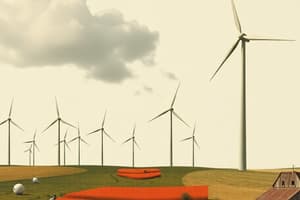Podcast
Questions and Answers
What is a wind farm?
What is a wind farm?
- A collection of wind patterns
- A collection of wind energy converters (correct)
- A group of engineers working on wind turbine technology
- A type of renewable energy source
Where are wind farms often located for optimal efficiency?
Where are wind farms often located for optimal efficiency?
- Valleys and low-lying areas
- Mountaintops or areas with natural wind patterns (correct)
- Desert regions with low wind speeds
- Urban areas with high pollution levels
What is the main purpose of wind turbines in a wind farm?
What is the main purpose of wind turbines in a wind farm?
- To store electrical energy
- To harness the sun's energy
- To convert moving air into electrical energy (correct)
- To generate kinetic energy
How tall can offshore wind turbines be?
How tall can offshore wind turbines be?
What is a potential ecological concern related to wind farms?
What is a potential ecological concern related to wind farms?
How do wind turbines contribute to electricity generation?
How do wind turbines contribute to electricity generation?
Flashcards are hidden until you start studying
Study Notes
Understanding Wind Farms
A wind farm is a collection of wind turbines that work together to generate electricity from the wind. Scientists and engineers have developed ways to convert the kinetic energy of moving air into electrical energy using wind turbines. Wind energy, commonly known as wind power, is a type of renewable energy that produces no air or water pollution and has near-zero operating costs after initial setup. Wind turbines come in various sizes, from those capable of powering a single household to massive machines that can generate enough electricity for thousands of homes annually.
Location and Design
To optimize efficiency, wind farms are often situated on mountaintops or in areas where natural wind patterns occur. For example, offshore wind farms are placed in bodies of water to maximize wind speeds. These turbines can be up to 200 feet (60 meters) long and as tall as a 20-story building, with blades that spin to turn a shaft connected to a generator. The hub height for utility-scale land-based wind turbines has risen significantly, reaching around 98 meters in some cases.
Ecological Impacts
While wind energy is predominantly seen as beneficial for curbing carbon emissions and promoting sustainability, it does have certain environmental implications. One concern relates to bird collisions caused by spinning turbine blades; however, this issue pales in comparison to the harm done by power lines and buildings. Another impact involves noise pollution and visual aesthetics, which can raise objections among nearby communities. The presence of wind farms might also affect local wildlife habitats, though this depends on the specific location and design of each facility.
Growth and Future Prospects
In recent decades, the wind energy industry has experienced rapid growth, driven partly by market forces and government policy initiatives aimed at combating climate change. Between 2000 to 2015 alone, the cumulative wind capacity around the world increased from 17,000 to over 430,000 megawatts. Experts anticipate that if this trend continues, wind power could fulfill one-third of the world's electricity needs by 2050.
Studying That Suits You
Use AI to generate personalized quizzes and flashcards to suit your learning preferences.




